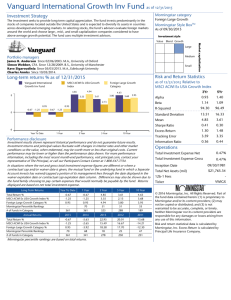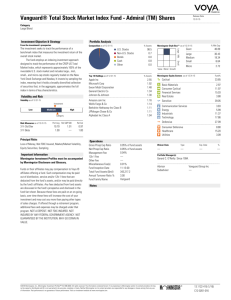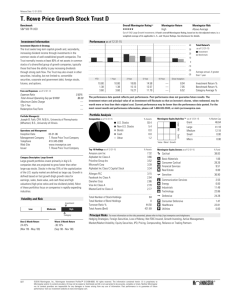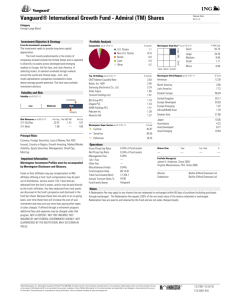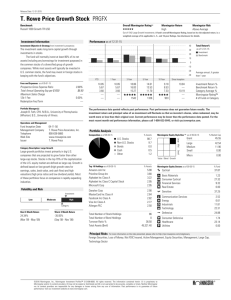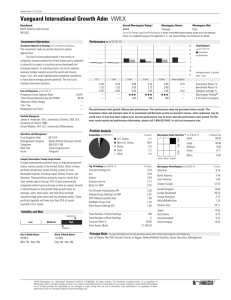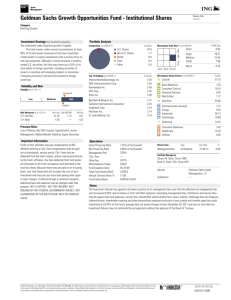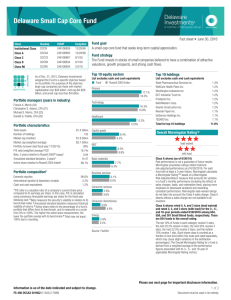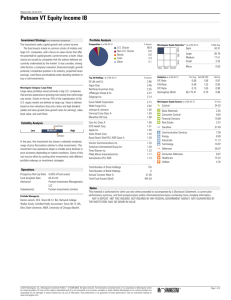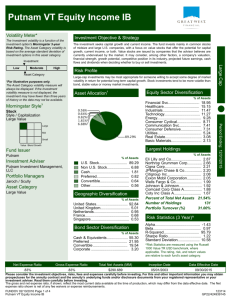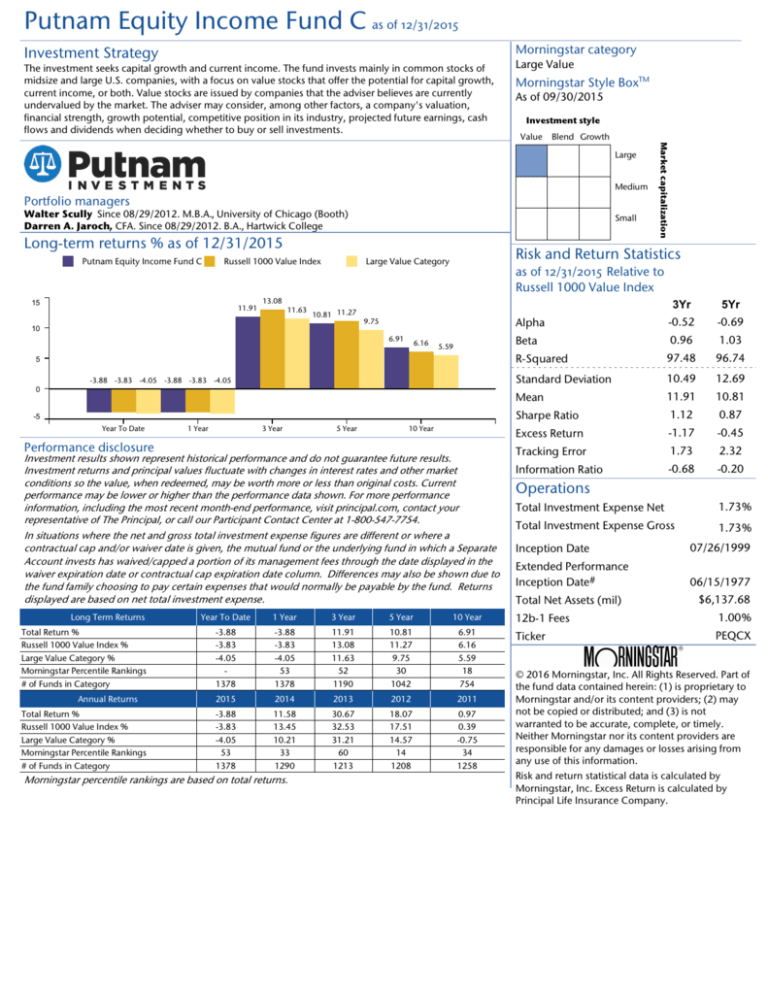
Putnam Equity Income Fund C as of 12/31/2015
Morningstar category
Investment Strategy
The investment seeks capital growth and current income. The fund invests mainly in common stocks of
midsize and large U.S. companies, with a focus on value stocks that offer the potential for capital growth,
current income, or both. Value stocks are issued by companies that the adviser believes are currently
undervalued by the market. The adviser may consider, among other factors, a company's valuation,
financial strength, growth potential, competitive position in its industry, projected future earnings, cash
flows and dividends when deciding whether to buy or sell investments.
Large Value
Morningstar Style BoxTM
As of 09/30/2015
Investment style
Value
Blend Growth
Medium
Portfolio managers
Walter Scully Since 08/29/2012. M.B.A., University of Chicago (Booth)
Darren A. Jaroch, CFA. Since 08/29/2012. B.A., Hartwick College
Small
Long-term returns % as of 12/31/2015
Putnam Equity Income Fund C
Russell 1000 Value Index
15
11.91
13.08
11.63
Risk and Return Statistics
Large Value Category
10.81 11.27
as of 12/31/2015 Relative to
Russell 1000 Value Index
9.75
10
6.91
6.16
5.59
5
-3.88 -3.83 -4.05 -3.88 -3.83 -4.05
0
-5
Year To Date
1 Year
3 Year
5 Year
10 Year
Performance disclosure
Investment results shown represent historical performance and do not guarantee future results.
Investment returns and principal values fluctuate with changes in interest rates and other market
conditions so the value, when redeemed, may be worth more or less than original costs. Current
performance may be lower or higher than the performance data shown. For more performance
information, including the most recent month-end performance, visit principal.com, contact your
representative of The Principal, or call our Participant Contact Center at 1-800-547-7754.
Total Return %
Russell 1000 Value Index %
Large Value Category %
Morningstar Percentile Rankings
# of Funds in Category
Annual Returns
Total Return %
Russell 1000 Value Index %
Large Value Category %
Morningstar Percentile Rankings
# of Funds in Category
Year To Date
1 Year
3 Year
5 Year
10 Year
-3.88
-3.83
-4.05
1378
-3.88
-3.83
-4.05
53
1378
11.91
13.08
11.63
52
1190
10.81
11.27
9.75
30
1042
6.91
6.16
5.59
18
754
2015
2014
2013
2012
2011
-3.88
-3.83
-4.05
53
1378
11.58
13.45
10.21
33
1290
30.67
32.53
31.21
60
1213
18.07
17.51
14.57
14
1208
0.97
0.39
-0.75
34
1258
Morningstar percentile rankings are based on total returns.
3Yr
5Yr
Alpha
-0.52
-0.69
Beta
0.96
1.03
R-Squared
97.48
96.74
Standard Deviation
10.49
12.69
Mean
11.91
10.81
Sharpe Ratio
1.12
0.87
Excess Return
-1.17
-0.45
Tracking Error
1.73
2.32
Information Ratio
-0.68
-0.20
Operations
In situations where the net and gross total investment expense figures are different or where a
contractual cap and/or waiver date is given, the mutual fund or the underlying fund in which a Separate
Account invests has waived/capped a portion of its management fees through the date displayed in the
waiver expiration date or contractual cap expiration date column. Differences may also be shown due to
the fund family choosing to pay certain expenses that would normally be payable by the fund. Returns
displayed are based on net total investment expense.
Long Term Returns
Market capitalization
Large
Total Investment Expense Net
1.73%
Total Investment Expense Gross
1.73%
Inception Date
07/26/1999
Extended Performance
Inception Date#
06/15/1977
Total Net Assets (mil)
$6,137.68
12b-1 Fees
1.00%
Ticker
PEQCX
© 2016 Morningstar, Inc. All Rights Reserved. Part of
the fund data contained herein: (1) is proprietary to
Morningstar and/or its content providers; (2) may
not be copied or distributed; and (3) is not
warranted to be accurate, complete, or timely.
Neither Morningstar nor its content providers are
responsible for any damages or losses arising from
any use of this information.
Risk and return statistical data is calculated by
Morningstar, Inc. Excess Return is calculated by
Principal Life Insurance Company.
Putnam Equity Income Fund C as of 12/31/2015
Portfolio information†
Composition as of 09/30/2015
Top ten holdings
1.
2.
3.
4.
5.
6.
7.
8.
9.
10.
% of net
assets
Eli Lilly and Co
Northrop Grumman Corp
Cigna Corp
JPMorgan Chase & Co
Citigroup Inc
Exxon Mobil Corporation
Wells Fargo & Co
Johnson & Johnson
Comcast Corp Class A
Coty Inc Class A
2.87
2.65
2.21
2.20
2.07
2.04
1.98
1.91
1.88
1.67
% of net assets in top ten holdings*
Stock Sector Breakdown
Analysis
# of Stock Hldgs
# of Bond Hldgs
# of Other Hldgs
AvgMktCap (mil)
Turnover Ratio
P/C Ratio
P/B Ratio
P/E Ratio
21.49
112
0
18
$43,312.41
29%
7.93
1.70
14.98
% of net assets
Cyclical
Consumer Cyclical
Basic Materials
Financial Svcs
Real Estate
32.87 Defensive
8.71 Healthcare
2.13 Consumer Defensive
18.95 Utilities
3.08
% of net assets
27.71 Sensitive
% of net assets
39.43
15.15 Technology
7.32 Industrials
5.24 Energy
Comm Svcs
11.27
11.47
9.28
7.41
x
Returns shown for periods of less than one year are not annualized. Annualized total returns measure net investment income and capital gain or loss from
portfolio investments as an annualized average, assuming the reinvestment of dividends, and without adjusting for loads.
Insurance products and plan administrative services are provided by Principal Life Insurance Company. Securities are offered through Princor Financial
Services Corporation, 800-547-7754, member SIPC, and/or independent broker dealers. Securities sold by a Princor Registered Representative are offered
through Princor ®. Princor and Principal Life are members of the Principal Financial Group®, Des Moines, IA 50392. Certain investment options may not be
available in all states or U.S. commonwealths.
Investors should carefully consider a mutual fund’s investment objectives, risks, charges and expenses prior to investing. A prospectus, or summary prospectus
if available, containing this and other information can be obtained by contacting a financial professional, visiting principal.com, or by calling 800-547-7754.
Read the prospectus carefully before investing.
Russell 1000 Value Index is a market-capitalization weighted index of those firms in the Russell 1000 with lower price-to-book ratios and lower forecasted
growth values.
Past performance is no guarantee of future results. Market indices have been provided for comparison purposes only. They are unmanaged and do
not reflect fees or expenses. Individuals cannot invest directly in an index.
Alpha - The difference between an investment's actual returns and its expected performance, given its level of risk (as measured by beta). Beta - An
investment's sensitivity to market movements. R-squared - Ranges from 0 to 100 and reveals how closely an investment's returns track those of a
benchmark index. Standard Deviation - Measures how much an investment's returns are likely to fluctuate. Mean - Represents the annualized total return
for a fund over 3 and 5 years. Sharpe Ratio - Measures how an investment balances risks and rewards. The higher the Sharpe ratio, the better the
investment's historical risk-adjusted performance. Excess Return - The difference between a manager's return and the return of an external standard such as
a passive index. Tracking Error - The standard deviation or volatility of excess returns. Information Ratio - A risk-adjusted measure commonly used to
evaluate an active manager's involvement skill. It's defined as the manager's excess return divided by the variability or standard deviation of the excess
return.
Average Market Cap - The overall "size" of a stock investment option's portfolio. It is the geometric mean of the market capitalization for all of the stocks it
owns and is calculated by raising the market capitaliation of each stock to a power equal to that stock's stake in the portfolio. The resulting numbers are
multiplied together to produce the geometric mean of the market caps of the stocks in the portfolio, which is reported as average market capitalization.
Price/Cash Flow (projected) Ratio - The ratio of the company's most recent month-end share price to the company's estimated cash flow per share
(CPS) for the current fiscal year. Cash flow measures the ability of a business to generate cash and it acts as a gauge of liquidity and solvency. Morningstar
calculates internal estimates for the current year CPS based on the most recently reported CPS and average historical cash flow growth rates. Price/cash flow
(projected) is one of the five value factors used to calculate the Morningstar Style Box. For portfolios, this data point is calculated by taking an asset-weighted
average of the cash flow yields (C/P) of all the stocks in the portfolio and then taking the reciprocal of the result. Price/Projected Earnings Ratio - The
ratio of the company's most recent month-end share price to the company's estimated earnings per share (EPS) for the current fiscal year. If a third-party
estimate for the current year EPS is not available, Morningstar will calculate an internal estimate based on the most recently reported EPS and average
historical earnings growth rates. Price/projected earnings is one of the five value factors used to calculate the Morningstar Style Box. For portfolios, this data
point is calculated by taking an asset-weighted average of the earnings yields (E/P) of all the stocks in the portfolio and then taking the reciprocal of the result.
Price/Book (projected) Ratio - The ratio of the company's most recent month-end share price to the company's estimated book value per share (BPS) for
the current fiscal year. Book value is the total assets of a company, less total liabilities. Morningstar calculates internal estimates for the current year BPS based
on the most recently reported BPS and average historical book value growth rates.
†
The Portfolio Composition depicts a breakdown of the investment option's portfolio holdings, as of the date listed, into general investment classes. The
x-axis represents the percentage each investment group holds, with the y-axis representing a zero value. Values to the right of the y-axis represent long
security positions, while values to the left of the y-axis represent short security positions. The table to the right of the bar chart sums these two values to
present the net emphasis of each investment group. Due to rounding, the total net position may not equal 100%. Long positions involve buying a security
and selling it later, with the hope that the security price rises over time. In contrast, short positions are taken to benefit from anticipated price declines.
* Values may exceed 100% if both long and short positions are included in the portfolio.

